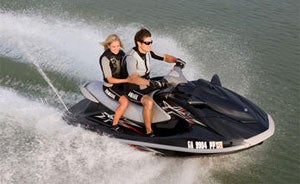Fuel-Saving Tips for Personal Watercraft
How to run your PWC on the cheap
The 2011 riding season (also known as Spring and Summer) is fast approaching. Unfortunately, that arrival also seems to be coinciding with an increase once again in gas prices. Week after week they’ve ticked upward. And while we can’t yet predict with any certainty where they’ll be this summer, chances are they’re not going to be on the downhill side of the slope.
Just deal with it? Not so fast, Mr. Gas Guzzler. Here’s a few things you can do to keep some of that hard-earned money in your pocket for the next ride…without killing all your fun.
Turn to the streets. Literally. While marinas may be the most convenient supply source while you’re out on the water, a little planning ahead can save you a bundle. Try to buy your fuel away from the water, on your way to or from the launch ramp, at a normal gas station. Their prices are significantly lower than what you’ll pay at the lake, river, or waterway. Looking for the best deals? Download one of the convenient fuel-price “apps” available for most smart phones. These little gems of code will tell you where you can strike the best deals in town.
 The easiest way to save money on fuel is to ease up on the throttle.
The easiest way to save money on fuel is to ease up on the throttle.Go slow-er. We know nobody wants to ruin their fun by putting along at a snail’s pace. Still, by slowing down just a little, you can achieve big savings in fuel consumption. Take the Yamaha FX SHO. At full throttle, it will likely burn in the neighborhood of 21 gallons per hour. Sea-Doo’s RXT-X? Expect it to consume about the same at full tilt. Kawasaki’s Ultras will likely burn even more, as much as 24 gph. That’s the price you pay for performance, but keep in mind the savings you’ll get if you tame those speeds just part of the time. Cruising along at 35 mph? Those consumption numbers drop dramatically, as low as 7-8 gallons per hour for these high-end flagships.
Studies have shown that a PWC’s fuel-efficiency stays fairly level in the midrange of its powerband. It increases dramatically, however, in the final 20-percent of the curve. Tap that top fifth of the powerband and you can expect to see the fuel needle dip…fast. Avoid it and expect your range to increase just as quickly.
 Yamaha’s VX Deluxe is a fuel sipper compared to the high horsepower machines.
Yamaha’s VX Deluxe is a fuel sipper compared to the high horsepower machines.Downsize. Of course, you could also downgrade your ride. Entry-level machines like the Yamaha VX, Sea-Doo GTI, and Kawasaki STX-15F, burn as little as 4-5 gallons at a 35 mph cruise. Even at full speed, the VX should still burn less than 7 gallons per hour.
Just can’t trust yourself to keep that finger off the throttle? Use a manufacturer’s low RPM mode to keep that itchy digit in check. Once simply used to limit a boat’s top speed, in recent years they’ve been branded as fuel-savers.
 Using Sea-Doo’s learning key will keep speeds down and fuel consumption to a minimum.
Using Sea-Doo’s learning key will keep speeds down and fuel consumption to a minimum.Auto-matic. Other fuel-saving tips can be borrowed from that other four-stroke you’re probably familiar with — your car. Start by keeping your boat in tune. Follow your maintenance schedule and keep your craft in tip-top shape. When you’re not trying to show off for your buddies (or just experiencing the thrill), accelerate smoothly rather than squeezing the throttle for all its worth. And when you’re cruising on a long-distance ride, back off to a more comfortable speed that avoids the thirstiest range of your craft’s powerband.
Finally, use cruise control if your vehicle has the option. The steady speed it maintains will likely prove more efficient than your trigger finger can duplicate.
Related Reading
A Closer Look at PWC Fuel Efficiency
What You Should Know About Ethanol in Your PWC’s Fuel
Things to Consider Before Letting a Friend Ride Your PWC
Five Tips for a Worry-Free Summer
Get PersonalWatercraft.com in your Inbox!
Like PersonalWatercraft.com on Facebook
Comments
Most Popular

2025 Yamaha JetBlaster PRO 2-Up Review

2024 Kawasaki Jet Ski STX 160X Review

Remembering the Sea-Doo XP

Whatever Happened to the Wetbike?

2025 Yamaha JetBlaster Review











 Your Privacy Choices
Your Privacy Choices